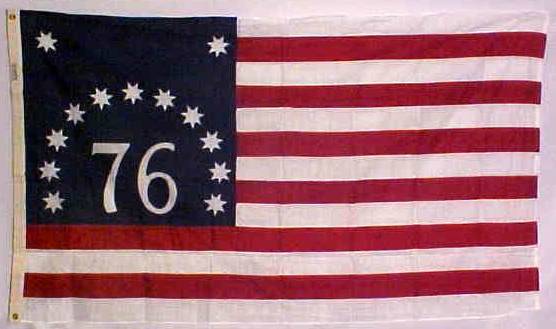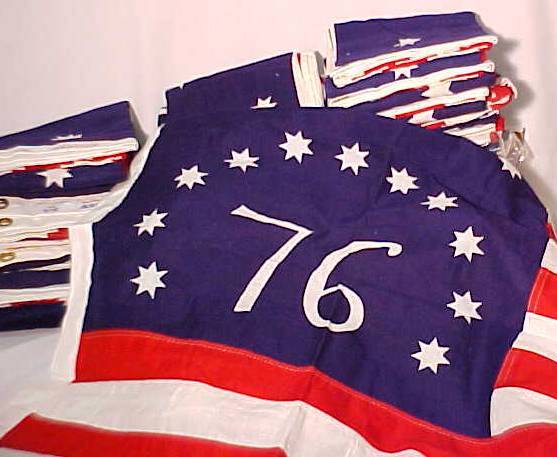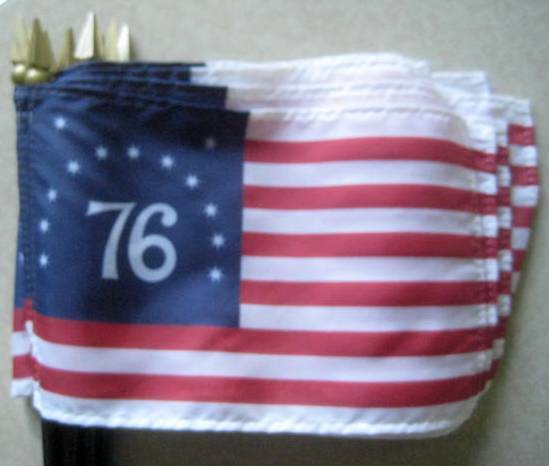Page Title: Bennington Flag MADE IN USA SEE ALSO: Defiant Flags
Defiant Flags Bennington Flags Betsy Ross
Civil War Flags North Historical Flags Washington Flags
Burgoyne, the British General operating in northern New York, in the Revolutionary War, heard that the Americans had collected some military supplies at Bennington, Vermont. He sent an expedition men to capture them. Colonel John Stark, a hero of Bunker Hill, with 2,000 Americans set out to oppose the British. When Stark saw the British advancing down the road he pointed them out to his brave troops and said: Boys, there they are. We beat them today, or Molly Stark's a widow. The Green Mountain Boys, fighting Indian fashion, practically annihilated the British Regulars. Only about 1,400 British troops about half were killed or captured. It was the loss of these men that contributed much to the failure of Burgoyne's campaign, which ended in disaster with the surrender of his Army at Saratoga, New York, October 7, 1777, a death blow to the British.
|
All are made in USA; All have canvas heading and brass grommets |
 |
||
|
Bennington 4x6" $1.25 Limited to stock on hand Nylon Bennington Flags |
|||
| Item Number | Size | Price Each | |
| #BEN23N Nylon Bennington Flag, embroidered design, sewn stripes | 2x3' | $44.85 | |
| #BEN35N Nylon Bennington Flag embroidered design, sewn stripes | 3x5' | $58.00 | |
| #BEN46N Nylon Bennington Flag appliquéd design, sewn stripes | 4x6' | $90.00 | |
| #BEN58N Nylon Bennington Flag appliquéd design, sewn stripes | 5x8' | $125.25 | |
|
Heavy Cotton Bennington Flags Heavyweight cotton spun from sturdy 2 ply yarns. Recreates an authentic look and feel of a time gone by. |
|||
| Item Number | Size | Price Each | |
| #BEN23C Heavy Cotton Bunting Bennington Flag Embroidered design, sewn stripes | 2x3' | $46.65 | |
|
#BEN35C Heavy Cotton Bunting Bennington Flag, Embroidered design, sewn stripes
This is an embroidered star
|
3x5' |
$63.50
|
|
|
#BEN46C Heavy Cotton Bunting Bennington Flag, appliquéd design, sewn stripes
|
4x6' |
$92.00 |
|
Bennington Flag History- Mistakenly referred to by many as "The Bicentennial Flag" because of its popularity in 1976. The Bennington Museum in Bennington VT houses the flag. Oral tradition states that it flew at the Battle of Bennington in 1777. This tradition is now known to be a myth. The museum's fiber analysis of the flag in 1995 places its probable creation circa 1814 for use during the War of 1812. Revolutionary war veteran Nathaniel Fillmore may have been responsible for its creation. The "76" reference in the design would be an expression of his patriotic enthusiasm during the second war with England. It is the earliest known flag made entirely of cotton. While her exact origin may remain a riddle, The Bennington Flag is one of America's most beloved historical flags.
Jeff Bridgeman dates it much later: "This familiar design, much reproduced in 1976 for the Bicentennial, has an arch of 13 stars in its canton over the numerals “76”. Once thought to be the earliest surviving Stars & Stripes, it was proved by flag expert Grace Rogers Cooper of the Smithsonian, to be no earlier then the 1840’s. And I suspect that it is actually a centennial flag made with some 1840’s fabrics. In my experience with early Stars & Stripes, this would make much more sense, as similarities exist between the Bennington flag and other centennial designs, while I know of no flags with “76” in the canton or stripes made before 1876. Nor is the number “76” typically included in earlier textiles, whether of pieced construction or printed, homemade or otherwise."
An Article For “Focus”, The Semi-Annual Journal Of The Antiques Council, Winter 2006
by Jeff Bridgman, 2006
The url for this page is http://flagguys.com/benningtonflag.html


